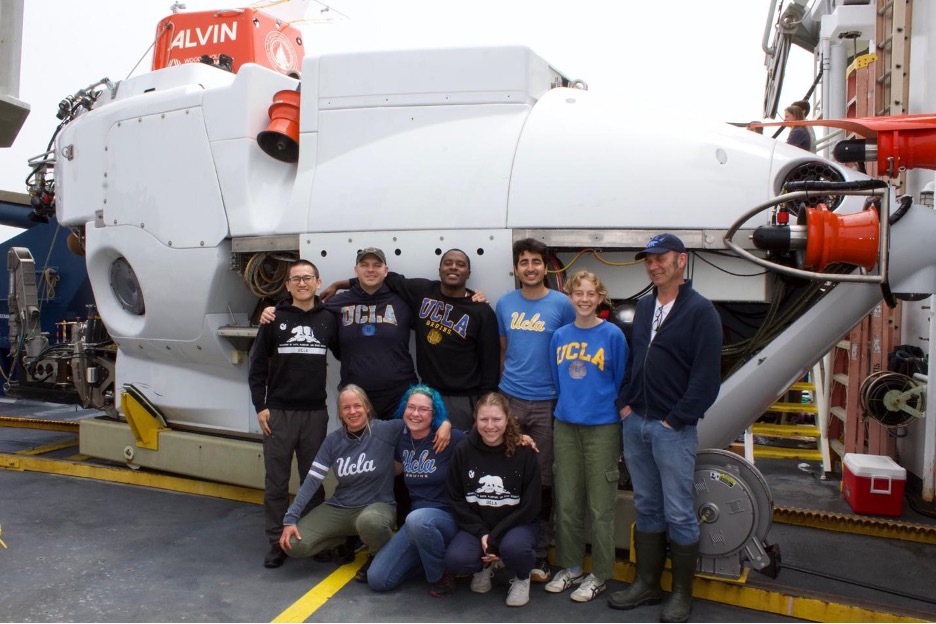In June of 2023, the research group of Tina Treude, professor of Earth, Planetary and Space Science and Atmospheric and Oceanic Sciences, set ‘sail’ to participate in two back-to-back marine research expeditions onboard the research vessel Atlantis, which hosts the famous deep-sea submersible Alvin. The total length of the two expeditions, which were supported by the National Science Foundation and organized by the Woods Hole Oceanographic Institution, was over 5 weeks and took the group to two different types of marine environments off the coast of southern California.
The first expedition focused on microbial processes in the oxygen minimum zone of the Santa Barbara Basin. High productivity of plankton in the surface water and weak ventilation of the deep basin water triggers a strong decline of oxygen when bacteria feed on decaying planktonic biomass. The degradation of the organic material at the seafloor initiates a complex set of microbial and chemical processes, including the development of massive sulfur bacteria mats, which feed on hydrogen sulfide produced in the sediment. While most of these processes are natural, the scientists are also interested in understanding potential intensification and alteration of the processes related to human impacts such as climate change.
For their research, the scientists descended to the seafloor (maximum depth around 590 m) with the submersible Alvin for the deployment of chambers to measure fluxes of chemicals (such as oxygen, nitrate, sulfide) into and out of the sediment. Further analytical support was provided by the cute autonomous underwater vehicle (AUV) Sentry, which completed several pre-programmed dives through the Santa Barbara Basin to measure oxygen distribution and to monitor seafloor coverage of the sulfur bacteria mats. This expedition was a collaboration with professor David Valentine of UC Santa Barbara, Dr. Felix Janssen of the Alfred Wegener Institute in Germany, and professor Tania Anders of Mt. San Antonio College.
The second expedition aimed at cold seeps that release fossil methane from the seafloor. Cold seeps are found at many locations off the coast of southern California and seepage is often facilitated through migration of methane along tectonic fault systems. The methane serves as an energy and carbon source for many organisms and creates special cold seep communities. The seep ecosystem usually starts with microbes, who feed on the methane and provide biomass for other organisms higher up in the food chain. The overall aim of the project was to understand the connectivity between methane and organisms and the importance of cold seeps for the overall health of the deep-sea ecosystem. On their dives to the up to 1000 m deep methane seeps, the scientists collected seep rocks (carbonates made from methane-derived carbon) and sediments to study methane-eating microbes and animals associated with this ecosystem. This expedition was a collaboration with professor Lisa Levin of the Scripps Institute of Oceanography, professor Shana Goffredi of Occidental College, and professor Victoria Orphan of Caltech.

Diving with a deep-sea submersible such as Alvin is a dream come true for many marine scientists. It is not unlike boarding a spaceship – few people in the world get a chance to experience it. Before boarding the submersible, scientists receive safety training and must obey several safety rules, such as only wearing flame-resistant clothes and leaving any non-tested electronics such as cellphones behind. All Alvin pilots are Navy-trained and the solid titanium sphere that holds the humans is approved for dives up to 6,500 m (21,325 feet). Once on board, the dive team (usually two scientists and one pilot), gets busy quickly to make sure samples requested are taken and documented with video cameras. The usual 6-8 hours in the sub fly by quickly. For the hungry ones, lunch boxes with sandwiches and chocolate are provided – so is a ‘toilet’ in the form of a plastic bottle. When asked what their most memorable moment in the submersible was, many mention the bioluminescent glow of organisms in the darkness of the deep sea. Once returned to the surface, those who experienced their first Alvin dive are welcomed back by the science crew with a bucket of ice-cold water, a joyful ceremony known as the ‘Alvin baptism’.
In late spring 2024, professor Treude’s research group will get closer to Alvin’s dive limit when they will explore methane seeps off Kodiak Island, Alaska at depths up to 5,500 m. Data gained during this future expedition will be compared to data from the shallower southern Californian seeps to study shifts in the relevance of methane for the ecosystems relative to water depth.
See More About the 4-Female-PI Expedition
 The UCLA team in front of the deep-sea submersible Alvin (Photo Credit: Tania Anders)
The UCLA team in front of the deep-sea submersible Alvin (Photo Credit: Tania Anders)